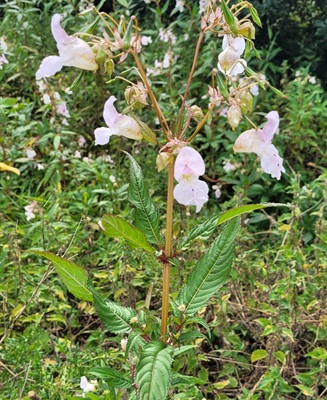Flower Properties
| Property | Value |
|---|---|
| English Name | Hymalayan Balsam |
| MainColor | Pink |
| PlantType | |
| Growth Type | |
| Season | August |
| ImageUrl | Impatiens-001 |
| Photographer | DP |
| Location | Cheshire |
| Human Toxicity |
Flower Details
Description
Himalayan Balsam is a tall, annual plant that can reach up to 2.5 metres in height, featuring pink to purple flowers and green, succulent stems. Its leaves are broad and serrated, growing in opposite pairs along the stem. The plant is known for its explosive seed pods that can disperse seeds over a considerable distance.
Distribution
Originally from the Himalayas, it has become widespread in the UK and other parts of Europe, often found in damp, shady areas such as riverbanks and woodland edges. Its rapid growth and ability to outcompete native species have made it an invasive species in many regions.
Medicinal/Other Uses

Historically, it has been used in traditional medicine for its anti-inflammatory properties and to treat skin conditions. The plant is also sometimes used in gardening for its ornamental value.
Edibility

The young shoots and leaves are edible and can be consumed raw or cooked, although they are best eaten in moderation. The flowers are also edible and can be used as a garnish.
Human Toxicity

While some parts of the plant are edible, caution should be taken as they can cause digestive upset in some individuals. It is also important to control its spread due to its invasive nature. Mildly Toxic - ingestion of large amounts may cause stomach upset.
Pet Toxicity

Non Toxic to pets - generally considered safe for dogs and cats, but ingestion may cause mild gastrointestinal upset.
